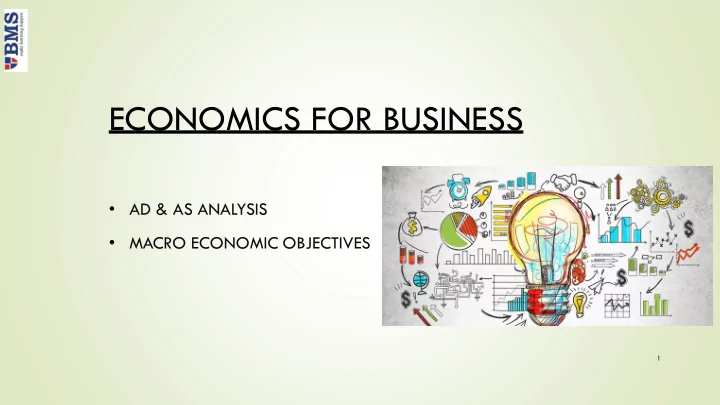

ECONOMICS FOR BUSINESS • AD & AS ANALYSIS • MACRO ECONOMIC OBJECTIVES 1
AGGREGATE DEMAND Aggregate or total demand is the sum of planned consumption (C), investment (I), government expenditures (G), and net exports (x- m) within one economy. AD= C + I + G + (X – M)
THE AGGREGATE DEMAND CURVE • x axis shows the value of output in real GDP • The y axis shows the price level 3
CHANGES IN AGGREGATE DEMAND A change in any factor other than the price level will shift AD • Some factors that may influence buying plans other than the price level are : • Fiscal policy and monetary policy • Changes in the world economy • Expectations
CHANGES IN AGGREGATE DEMAND Price level Increase in aggregate demand AD 1 Decrease in aggregate demand AD 0 AD 2 0 5 Real GDP
THE AGGREGATE SUPPLY CURVE The as curve shows the quantity of real GDP (total output) supplied at different price levels. • It is upward-sloping because firms will be induced to bring more products to the market if the price level rises. A/supply (output) depends upon inputs: examples: • The quantity and price of labour • The quantity and price of capital • The state of technology • Productivity of factors 6
SHIFTS IN AGGREGATE SUPPLY • A/supply will increase if : • Wage levels fall • Raw material prices fall • There are improvements in technology or productivity • A/supply will decrease if : • Wage levels rise • Raw material prices rise • Productivity declines • E.G. A rise in the money wage rate or oil prices 7
THE KEYNESIAN VIEW OF AS Keynes argued that prices and wages are inflexible, so ad would create increased output with little change in price level • Therefore the as curve is horizontal. 8
THE CLASSICAL VIEW OF AS • This theory states that wages & prices are flexible and automatically adjust the economy. • When ad falls, inventories grow, but are eliminated as firms lower their prices. 9
AGGREGATE SUPPLY Full Employment • As the economy approaches the level of full employment, resources become scarce. The capacity to grow decreases while resources prices rise. • These effects cause as to become steeper and inelastic towards the full employment level of income 10
3 RANGES OF AGGREGATE SUPPLY • The keynesian view is more likely to hold in recession. • The classical view is more likely to hold at full employment output. • Between these two ranges is the intermediate range when the as curve rises as the economy approaches full employment. 11
MACRO ECONOMIC EQUILIBRIUM • Occurs when the quantity of real GDP demanded equals the quantity of real GDP supplied • Where the AD and AS curves intersect. • At this point, sellers neither overestimate nor underestimate the real GDP demanded at a particular price. • Any difference between AD and AS will bring about a change in firms’ stock, and also cause firms to adjust their plans for the future. 12
MACROECONOMIC EQUILIBRIUM 13
MARCO ECONOMIC OBJECTIVES • Economic growth should be high and stable • Inflation should be low but not zero • Balance of payments • Low unemployment • Equal distribution of income • Environmental protection & conservation
OBJECTIVE 1- ECONOMIC GROWTH • Growth is measured using GDP/GNP statistics. It is a measurement of the national income. • Ideally an economy should have a sustainable rate of GDP growth. • If the growth rate is too low the income of the country is rising too slow and if the rate is too high it could indicate over consumption of limited resources. • Underdeveloped economies should target rapid growth rates while developed countries should look at a lower or stable/sustainable growth rate.
OBJECTIVE 2- LOW INFLATION • Inflation is the general rise in average price levels in the economy. • Inflation reduces the value of money and causes many issues such as reducing the amount of goods and services that can be consumed by the disposable income etc. • A negative inflation rate or deflation is also undesirable since it delays purchases. This is bad for businesses. • Hyperinflation is a rapid increase in price levels that devalue currencies causing people to minimize holdings in that currency.
OBJECTIVE 3-BALANCE OF PAYMENTS • BOP of a country is a record of all economic transactions its citizens have with the rest of the world. • BOP is made up of the capital account & the current account. • A large sustained deficit is undesirable because it can lead to a credit crunch. • A large surplus is also undesirable because it indicates over production and consumption or scares resources.
OBJECTIVE4 – LOW UNEMPLOYMENT • Unemployment rate can be defined as the number of people who are able to work, willing to work & actively looking for work, but unable to find a job at the current market wage rate. • High unemployment can create negative impacts including slow gdp growth, increase in govt. Welfare benefits, increase in crime etc. • Its impossible to have full employment since frictional unemployment will always exist. • The government must strive to minimize structural unemployment which is far more serious.
OBJECTIVE 5 – EQUAL DISTRIBUTION OF INCOME • Distribution of income looks at the gap between the rich and poor. Great the gap the bigger the inequality. • Lorenz curve helps us understand income distribution disparity • If the gap is too wide the low income earners will not be able to afford basic necessities. • Govt. Should strive to eradicate absolute poverty & relative poverty.
OBJECTIVE 6 – ENVIRONMENTAL PROTECTION • This objectives looks at the use of national resources and the process of conservation. • If scares resources are over consumed we run the risk of them running out too fast. It also looks at conservation for future generations • E.G. Crude oil, fish, timber, water etc.
CONFLICTING OBJECTIVES 28
Thank You!
Recommend
More recommend